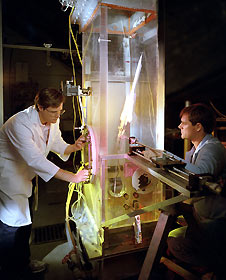
Save this image free of charge
in 800 pixels for layout use
(right click, Save as...)
|
|
Ref : S04835
Theme :
Astronotics - Misc. - Apollo History - etc. (108 images)
Title : Water Tunnel preparation for an SR-71 model test
Caption :
The NASA Dryden Flow Visualization Facility (FVF) was built in 1983 and is part of the Dryden Flight Research Center located at Edwards AFB, Edwards, California. The FVF is a convenient, inexpensive tool that provides a means by which complex flow fields can be observed. As the designs of advanced technology vehicles become more complex, water tunnels have become increasingly useful as a time- and cost-effective flow diagnostic tool. Since the start of its operation, the FVF's primary use has been to study highly complex 3-dimensional vortex flow on aircraft configurations. Because of the low Reynolds numbers obtainable in a water tunnel, it is best used to investigate flow regimes where the vortex flow is dominant over viscous flow effects. Ideally, a water tunnel is best used in the infant stages of aircraft development. Potential problems can be identified and a variety of fixes may be implemented before a substantially more expensive wind tunnel model is built and tested. Flow visualization in a water tunnel, however, is useful at any stage of aircraft development. Observation of the flow is a good first step toward providing physical explanations for anomalies or phenomena discovered during wind tunnel or flight tests. Once the causes are understood, possible configuration modifications can easily be investigated. The Dryden FVF is a convenient and inexpensive tool that can provide a qualitative, and sometimes quantitative, description of complex fluid phenomena. As the designs of advanced technology vehicles become more complex, water tunnels have become increasingly useful as a flow diagnostic tool. The visualization and interpretation of complicated fluid motions around isolated vehicle components and complete configurations in a time- and cost-effective manner can be key elements in the development of flow control concepts.
|
|

